#'non-diegetic' music is the soundtrack that only the audience can hear
Explore tagged Tumblr posts
Text
"I thought that was non-diegetic!" is now my VERY FAVORITE leaning-on-the-fourth-wall line ever.
#spoilers#although i will attempt to mitigate the spoilers by keeping the rest of the tags#buried underneath a row of chatter#so for the unfamiliar 'diegetic' music is music that exists in-universe#e.g. music on a radio or in a concert#'non-diegetic' music is the soundtrack that only the audience can hear#and sometimes the one can fade into the other#so into the spoilery section#doctor who spoilers#doctor who#facing a musical villain and x character says 'do you hear that music?' before magical music notes drag them off#and the doctor says 'i thought that music was non-diegetic!'#... so the doctor is now aware of the fourth wall???#are we going to be breaking the fourth wall for part of this season???#anyway yes fifteenth doctor is off to a very strong start imho
135 notes
·
View notes
Note
please help me- i used to be pretty smart but i’m having so much trouble grasping the concept of diegetic vs non-diegetic bdsm!
gfkjldghfd okay first of all I'm sorry for the confusion, if you're not finding anything on the phrase it's because I made it up and absolutely nobody but me ever uses it, but I haven't found a better way to express what I'm trying to say so I keep using it. but now you've given me an excuse to ramble on about some shit that is only relevant to me and my deeply inefficient way of talking and by god I'm going to take it.
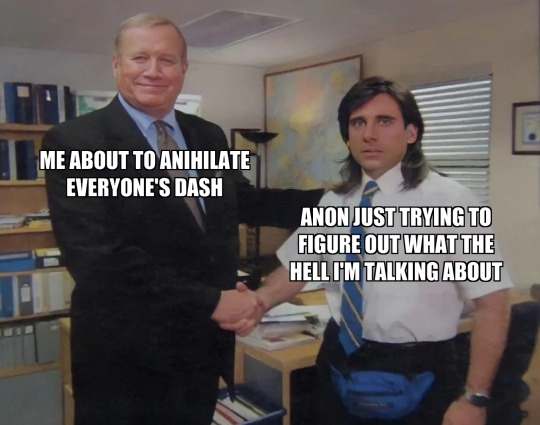
SO. the way diegetic and non-diegetic are normally used is to talk about music and sound design in movies/tv shows. in case you aren't familiar with that concept, here's a rundown:
diegetic sound is sound that happens within the world of the movie/show and can be acknowledged by the characters, like a song playing on the stereo during a driving scene, or sung on stage in Phantom of the Opera. it's also most other sounds that happen in a movie, like the sounds of traffic in a city scene, or a thunderclap, or a marching band passing by. or one of the three stock horse sounds they use in every movie with a horse in it even though horses don't really vocalize much in real life, but that's beside the point, the horse is supposed to be actually making that noise within the movie's world and the characters can hear it whinnying.
non-diegetic sound is any sound that doesn't exist in the world of the movie/show and can't be perceived by the characters. this includes things like laugh tracks and most soundtrack music. when Duel of Fates plays in Star Wars during the lightsaber fight for dramatic effect, that's non-diegetic. it exists to the audience, but the characters don't know their fight is being backed by sick ass music and, sadly, can't hear it.
the lines can get blurry between the two, you've probably seen the film trope where the clearly non-diegetic music in the title sequence fades out to the same music, now diegetic and playing from the character's car stereo. and then there are things like Phantom of the Opera as mentioned above, where the soundtrack is also part of the plot, but Phantom of the Opera does also have segments of non-diegetic music: the Phantom probably does not have an entire orchestra and some guy with an electric guitar hiding down in his sewer just waiting for someone to break into song, but both of those show up in the songs they sing down there.
now, on to how I apply this to bdsm in fiction.
if I'm referring to diegetic bdsm what I mean is that the bdsm is acknowledged for what it is in-world. the characters themselves are roleplaying whatever scenarios their scenes involve and are operating with knowledge of real life rules/safety practices. if there's cnc depicted, it will be apparent at some point, usually right away, that both characters actually are fully consenting and it's all just a planned scene, and you'll often see on-screen negotiation and aftercare, and elements of the story may involve the kink community wherever the characters are. Love and Leashes is a great example of this, 50 Shades and Bonding are terrible examples of this, but they all feature characters that know they're doing bdsm and are intentional about it.
if I'm talking about non-diegetic bdsm, I'm referring to a story that portrays certain kinks without the direct acknowledgement that the characters are doing bdsm. this would be something like Captive Prince, or Phantom of the Opera again, or the vast majority of bodice ripper type stories where an innocent woman is kidnapped by a pirate king or something and totally doesn't want to be ravished but then it turns out he's so cool and sexy and good at ravishing that she decides she's into it and becomes his pirate consort or whatever it is that happens at the end of those books. the characters don't know they're playing out a cnc or D/s fantasy, and in-universe it's often straight up noncon or dubcon rather than cnc at all. the thing about entirely non-diegetic bdsm is that it's almost always Problematic™ in some way if you're not willing to meet the story where it's at, but as long as you're not judging it by the standards of diegetic bdsm, it's just providing the reader the same thing that a partner in a scene would: the illusion of whatever risk or taboo floats your boat, sometimes to extremes that can't be replicated in real life due to safety, practicality, physics, the law, vampires not being real, etc. it's consensual by default because it's already pretend; the characters are vehicles for the story and not actually people who can be hurt, and the reader chose to pick up the book and is aware that nothing in it is real, so it's all good.
this difference is where people tend to get hung up in the discourse, from what I've observed. which is why I started using this phrasing, because I think it's very crucial to be able to differentiate which one you're talking about if you try to have a conversation with someone about the portrayal of bdsm in media. it would also, frankly, be useful for tagging, because sometimes when you're in the mood for non-diegetic bodice ripper shit you'd call the police over in real life, it can get really annoying to read paragraphs of negotiation and check-ins that break the illusion of the scene and so on, and the opposite can be jarring too.
it's very possible to blur these together the same way Phantom of the Opera blurs its diegetic and non-diegetic music as well. this leaves you even more open to being misunderstood by people reading in bad faith, but it can also be really fun to play with. @not-poignant writes fantastic fanfic, novels, and original serials on ao3 that pull this off really well, if you're okay with some dark shit in your fiction I would highly recommend their work. some of it does get really fucking dark in places though, just like. be advised. read the tags and all that.
but yeah, spontaneous writer plug aside, that's what I mean.
#I found their original stuff while I was researching various waterhorses and their folklore for no reason#because one of the characters in their original work happens to be an each uisge#and then it turned out it ALSO included a lot of figures from welsh folklore in general#so yknow if you happen to have my incredibly specific hyperfixations you'll love it but even if you don't it's great#I didn't mean to bring up phantom of the opera so much it just happens to be very relevant to a lot of my talking points#I haven't actually seen it in years
19K notes
·
View notes
Text
A Tale of Two Earpods
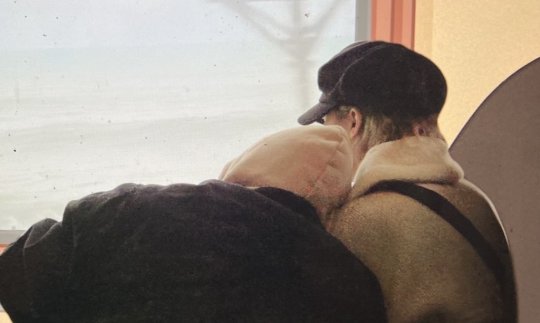
Have you ever sat on a train while listening to music, and while you're watching the landscape, you feel heightened emotions? There's probably a name for this occurrence. It's almost cinematic even. When you're listening to music, it enhances this wonderful sense of detachment as the world passes you by at high speed.
That's probably what jikook were feeling, too, traveling past the pretty and snowy coastline. A little detached from the world inside the train, yet grounded in the music they're listening to together. We are invited into that bubble through the sounddesign as it gently invites us to come into their mindset.
There's a reason why this scene stands out. Something beyond the fact that when Jungkook gently laid his head on Jimin’s shoulder, he crushed the last dregs of sanity I had left, I mean.
----
The actual music we hear is considered a 'non-diegetic' layer. It's not something Jikook can hear, but it's added in later in post-production. This way, it functions as a guide for the audience to feel something. BUT, there is a very important physical element at play in this scene that gives an extra emotional entry into the minds of our main characters. The earpods.
Jikook are cutely sharing a pair of earpods 🥺 This places them inside a little auditory bubble separate from the audience: we can't hear what they're listening to. Luckily, Jungkook provides us with a genre: anime music.
So when Jimin remarks that it feels like they're in an animation (little did they know the scene would include actual illustrations), it was all those elements at play for him as well. The music is giving him the feels.
The soundtrack tries to let us in on their earpods by overlaying this moment with violin music, but it doesn't quite cut it tbh. I'm sure copyrights prevented them from sharing the actual music they're listening to. When Jimin starts to get playful and pretends to be a crying dog!?!?!? the cutest little flute/accordion piece starts playing. It's adorable and kind of folksy.
Then suddenly, the music switches to this soft electric guitar piece we've heard before in AYS, often at the end of sentimental scenes, like at the end of episode 4 when they're on the catamaran. It's a very melancholy yet hopeful piece, promising that this is not the end but a new beginning. At least, that's what it makes me feel.
In the train scene, this piece isn't used to end the scene, but it surprisingly builds towards something, a high point.
Here the music is reflecting not only their emotions: the train ride is amazing, they're really enjoying themselves, and it feels like another core memory being made, but it's also a guide for US watching THEM in THEIR moment. Like a little snapshot made for the audience. This is also OUR core memory now. Again, linking us directly to jikook, but also keeping us at a safe distance.
This concept feels foundational for AYS. Truly a show for them AND for us.
The actual highpoint of the scene ends with a beat of silence as JK puts his head on Jimin’s shoulder. After all the music, the silence at this exact moment is VERY LOUD in order to emphasize this gesture. A WORLD STOP.

And that's what I felt when I first saw it. That little beat of silence was an exclamation point, a silent scream. Your heart stopped beating for a second there, right? The sound design danced us right up until that point, swaying us gently from side to side and then suddenly it dipped us and made everyone take note. The shot fades out, the diegetic noise of the train can still be heard, and almost like we had to take a breath to clear our head, ... we're back to reality with JK's voice. Sigh.
If you're still reading this, I don't know what to tell you,...you too are obsessed with jikook 😮💨 send help.
----
I rarely travel on trains anymore, but next time I do , I look forward to emptying my mind of real-world problems, and I'll think of this little Jikook snapshot instead.
#jikook#when i said id never get over that moment i meant it#send help#blogger needs to MOVE ON#sapporo hot springs here we come
101 notes
·
View notes
Text
in episode three of genloss, retrospectively it’s really clear that the show continues even as ranboo was released into the mall. even hetch suggests so by saying ranboo won’t be attacked by the showfall employees because he’s programmed them to consider him ‘part of the show’ - a show that’s ongoing.
one way in which this bridging of performance and reality is really cleverly shown is through the music. up until now, it’s safe to assume the soundtrack was non-diegetic meaning the characters couldn’t hear it. contrastingly, in the mall the music sounds like it’s being played over speakers like elevator music and so ranboo can probably hear it: the soundtrack becomes diegetic. this both implies ranboo is becoming more aware of their role in showfall’s media and that this media is not finished with them - the show must go on. it’s a really good and chilling way of portraying his state of semi-awareness. even as he walks around, ostensibly free, and sees the sets and props, the buzzing background music pervades the whole mall and turns it into a new stage.
they only truly break free when they break from the script - from the ‘expected’ behaviour that hetch promised would keep them safe from the security. this might just be a quirk of the sound design but the music even cuts out for a few seconds after ranboo makes his choice with the codes. like an immune system, the mall then begins to treat him as a foreign body which only highlights how assimilated he was before when he was doing what hetch told him and sticking to his role.
unfortunately, in the grand scheme of things, this only buys ranboo time. hetch swoops back into the part of mentor and ranboo buys into the fantasy again, following his ‘instruction’ and becoming his puppet once more. charlie tries to warn them ‘are you even you right now, is this what you want?’ but they don’t listen, they can barely hear him over the music, which is non-diegetic again - we’re fully immersed back into the performance. the grand crescendo of the button press, in which another person must be sacrificed, is the same song and dance ranboo has been following the entire time.
this fact becomes painfully clear when the real finale occurs and hetch essentially asks the audience if they want an encore.
#the music metaphor may have run away with me#but ranboo is a genius#and everyone who worked on this project did an amazing job#nathan hanover you legend#the music is so good and everyone involved in sound design also deserves a pat on the back#because figuring this all out LIVE must have been so tricky too#nathan hanover#generation loss#genloss#generation loss spoiler#generation loss spoilers#ranboo#ranboolive
78 notes
·
View notes
Note
What about if you did Live-Action movies? Though probably best not to do any very long or interconnected ones (like the MCU for example).
One of my choices would be Inspector Clouseau (played by Peter Sellers) from the Pink Panther films.
Here we go! (And you have no idea how happy it made me when you picked Sellers!Inspector Clouseau.)
I also don't know if you wanted regular movies or movie musical, both of which I can do. But it's just funny to me how half the cast would watch the musicals and be like, "How you guys breaking out into song and dance like that?! What, did you plan this?"
And the musical cast is like, "No?! I don't even remember doing that!"
(For those not in the know, musical numbers just help to progress the story and or be an entertainment piece for the audience, meaning they are non-diegetic, meaning that have no direct effect on the story world, like the soundtrack you hear during a movie.)
The Pink Panther (Inspector Clouseau) Ocean 11 (1960) (Danny Ocean) The Last Days (a 2013 Spanish science fiction thriller film which was amazing and I HIGHLY recommend it) (Marc) The A-Team (2010) (Murdock) Forrest Gump (Forrest Gump) Home Alone (Kevin McCallister) Jaws (Brody) Jurassic Park (Alan Grant) Back to the Future (Marty McFly or Doc Brown) V for Vendetta (V) It’s a Mad Mad Mad Mad World (Captain Culpeper) Holes (Stanley Yelnats or Zero) Night at the Museum (Larry Daley) The Princess Bride (Westly or Buttercup) Legally Blonde (Elle Woods) Little Woman (1949) (Jo) Men in Black (Agent K or Agent J) The Matrix (Neo) Jumanji (But only the 1995 one) (Alan Parrish) Zathura: A Space Adventure (Astronaut) Sound of Music (Maria) West Side Story (1961) (Tony or Maria) My Fair Lady (Eliza Doolittle or Henry Higgins) The Music Man (1962) (Harold Hill or Marian Paroo) Mary Poppins (Bert) The Rocky Horror Picture Show (Frank-N-Furter) The Wizard of Oz (Dorthy) Labyrinth (Sarah or Jareth) How to Succeed in Business Without Really Trying (J. Pierrepont Finch) Singin' in the Rain (1952) (Don Lockwood or Kathy Selden or Cosmo Brown) Charlie and the Chocolate Factory (Charlie Bucket or Willy Wonka) Guys and Dolls (Sky Masterson or Nathan Detroit) Little Shop of Horrors (1986) (Seymour Krelborn) Annie (1982) (Annie) Tick, Tick… Boom! (Jonathan Larson) Grease (Danny Zuko or Sandy Olsson) Les Misérables (Jean Valjean or Cosette) Sweeney Todd: The Demon Barber of Fleet Street (Sweeney Todd) Phantom of the Opera (2004) (Christine Daaé) Meet Me in St. Louis (Esther Smith)
#main character syndrome (with exceptions)#the 40#the_ravenclaw_werewolf#ask & answer#hulkchloron99#movie 40
20 notes
·
View notes
Text
OK TIME FOR MY CLEO FROM 5 TO 7 RANT ON THIS SCENE
youtube
To really get why this scene is so beautiful, some context is necessary. Cléo from 5 to 7 is a French New Wave film that follows a singer who's awaiting a diagnosis that she's certain is cancer. The film follows her for two hours out of her day as she awaits the confirmation diagnosis; it's such a simple premise but it's genuinely so much better than I expected.
In this particular scene, she's meeting with her songwriters as they mess around and go over new songs for Cléo to sing, and they finally get to this particular song entitled "Sans toi". As she starts singing, you can see Cléo starting to get pulled deeper and deeper into the lyrics as the camera circles around until it reaches the point where Cléo is the only thing in front of a black background. At this point, she looks up from the lyric sheet and acknowledges the camera by staring straight at it, and through this decision we're fully able to see the emotional state she's in. You can see the tears rolling down her face as she pours her heart and soul into this song, and the acting is just so full of emotion that it really gets you in the heart. Cléo gets pulled into her own mind from this song as she relates it back to her impending diagnosis, and she pulls the audience in with her. Her pain is shown in such a hopeless way and it's not overdone: she's not outright sobbing, yet the pure emotion is so palpable as she pours out her soul into these lyrics. And when she finally gets to the end and her voice wavers, she and the audience both get pulled out of the moment and into reality. The black curtain is revealed to be the source of this void which is an absolutely brilliant use of the limit of the camera frame, but it also shows us that Cléo really does get lost in her mind during this song. She's so worried about her diagnosis that even the reminders of it in a song is enough to render her to tears in an absolutely heart-wrenching performance. It's just so beautiful, in both how it was shot and what it represents. It's a wonderful painting of Cléo's character and I'm still in awe over how amazing it is. Also this scene makes such an incredible use of diegetic music transitioning to non-diegetic music. Diegetic music is when the music in a film comes from an in-world source, and non-diegetic music is what you usually think of when you hear a movie soundtrack. When Cléo starts singing, it's only alongside the piano one of the songwriters is playing. But when she goes into her own mind, the song is now accompanied by violins. It's such a seamless transition but it's so impactful.
#I highly recommend this movie#it takes a bit to get going but it's really an amazing film#this scene especially hits me hard ever time I go back to watch it#it's so simple yet so damn compelling#you really feel for her and that's something that's really hard to accomplish well in a movie#cleo from 5 to 7#meso's movies#Youtube
5 notes
·
View notes
Text
Unlocking Film Magic: The Power of Music in Cinema
The profound influence of music on the emotionality of films cannot be overstated. From stirring cinematic soundtracks to meticulously composed scores, music serves not only as a backdrop but as a powerful story-enhancer. This is particularly true in places with a rich cinematic heritage such as New Jersey, where local filmmakers are increasingly recognizing the significant role of music in film production.
Emotional Amplification through Music
Music in film is not just an accessory; it's a vital component that intensifies emotions and heightens the narrative impact. An adeptly chosen score can turn a scene from mere visuals into a memorable, emotional experience. Think about the chilling strings in "Psycho" or the stirring melody in "Star Wars." These iconic film scores are exemplary in how they alter our perception and emotional engagement with the scenes.
Within the realm of sound design and film scoring, techniques such as the use of leitmotifs—recurrent themes associated with a particular character, location, or idea—are instrumental. The distinction between diegetic music (originating within the film's world) and non-diegetic music (external to the story's world) further illustrates how filmmakers manipulate audio cues to enhance storytelling. Employing silence or musical pauses at pivotal moments can also dramatically influence the viewer's emotional response.
The interplay of visuals and music is a sophisticated dance that, when executed well, can elicit deep emotional responses from the audience. Case studies from both classic and contemporary cinema reveal that the most poignant moments often arise from a harmonious blend of visual storytelling and musical accompaniment.
Integration Techniques
In the process of blending music with film narrative, careful thought and collaboration are required. From pre-production where filmmakers discuss the film’s emotional arc with composers, to establishing themes and motifs, this step is crucial for resonating melodies. During production, temporary music tracks can guide performances, while in post-production, the score is finely adjusted to fit the final edit, ensuring that each note and cue aligns with the on-screen action and dialogues.
Moreover, balancing the music with sound effects is paramount to ensure neither overshadows the other, maintaining an immersive audio experience for the audience.
New Jersey's Cinematic Vibrance
In New Jersey, a hub for diverse filmmaking talents, local creators are making significant strides in the music-film nexus. Filmmakers from this region are not only crafting compelling narratives but are also adept at utilizing music to amplify their storytelling. The state offers numerous resources for filmmakers to refine their understanding of music integration, encouraging a thriving filmic environment.
As we delve deeper into the symbiotic relationship between music and film, it’s clear that the auditory elements of a movie are as integral as its visuals. For filmmakers and composers alike, understanding and harnessing the power of music can transform simple scenes into unforgettable experiences. Moving forward, an ongoing exploration of this dynamic field will undoubtedly yield more nuanced and emotionally resonant films, particularly as technological advances continue to evolve the landscape of film production and sound design.
To truly captivate an audience, filmmakers are encouraged to collaborate closely with composers from the early stages, consider the emotional weight of their soundtracks, and experiment with various musical styles. Such an approach not only enhances the storytelling but also deepens the viewer’s connection to the film, proving that in cinema, what you hear is just as important as what you see.
/post/unlocking-film-magic-the-power-of-music-in-cinema
0 notes
Text
week 11
Sound
This time we learned all about the sound of the movie basically about dialogues ,background music , object sounds and etc and of course without any sound in a movie the film would be so bland and boring.
after that I learned something which I never knew was in sound like I never knew that there were different types of sound used in movies I always thought sound is only one thing and all the types comes under sound but when I learned that there were 2 types it got me curious on what they are.
so the two types of sound is diegetic and non diegetic sound so first if both the characters and the audience can hear it is known as diegetic sound but as for non diegetic sound it is any form of sound that does not specifically exist within the setting of the film itself.
so a brief of diegetic sound from what I understood is that what ever sound that you would hear if you were a character in the movie such as sirens, conversation, cheers, and more.
and for non diegetic its basically the sounds that are added in the movie while post- production(editing) For example, a film soundtrack is almost always non-diegetic sound because the characters don't hear it.

0 notes
Text
Settings in She-Ra
Today I will talk about setting and how She-Ra uses its settings to do some very cool things with its writing. I didn’t even notice all of these things until a recent rewatch because it’s so subtle and yet so brilliant at unconsciously making you notice things. TL;DR: The two major characters, Adora and Catra, are reflected in the show by a few major settings. And in this essay I will -
To understand settings in She-Ra, you need to understand that writing is rarely a cause-and-effect endeavor. Writing decisions and choices don’t just happen because something is the most likely to happen in the world of the story; things happen because the author writes them. So when something takes place in the Whispering Woods, it’s important to remember that was a deliberate decision for some event to happen there, not just because it’s a logical outcome. Following this, I will make a guess that She-Ra’s major settings are like an extended metaphor for the thoughts and feelings of its two major characters, Adora and Catra.
What tipped me off to this was a recent rewatch, when Adora and Catra confront each other at the end of Season 3. And it occurred to me just how often they confronted each other in the Whispering Woods. Seems odd, right? Another thing is that Adora goes on her own Hero’s Journey. The Hero goes into the Unknown, a supernatural place, and encounters challenges, only to grow past them and emerge a changed person, and returns to their life. Adora definitely changes; she literally transforms into She-Ra for the rest of the series, and She-Ra even changes again when Adora gets a new transformation.The Whispering Woods can certainly be defined as the Unknown, in a literal sense; even the princesses and native Etherians treat it with caution and confusion, because it’s so ancient and mystical. The Woods also exist as a boundary between the Horde and Brightmoon, a middle ground. If Adora’s journey begins in the Horde and ends in Brightmoon, she has to go through the Woods, the Unknown, in order to complete it. Adora’s journey is centered around her inner thoughts and feelings as much, or even more, as it is about winning a war. And these challenges to her thoughts and feelings usually take place in the Whispering Woods, which is a metaphor for her sense of self. Or else, they take place in First One’s ruins, which are in the Woods, and represent Adora going deeper into her thoughts.
No post of mine is complete without numerous examples, so let’s take it from the top. Adora and Catra leave the Horde, their home, to enter the Woods, and Adora encounters something strange and new there. Adora goes back, and Catra stays behind, metaphorically because Catra isn’t ready to start her own journey yet. Glimmer and Bow enter the ruins with Adora, and she slowly learns to let them into her life and they become her close friends. Adora gets to Brightmoon but enters the Woods again when she is unsure of what to do, and gets advice from Razz. (Which is really advice from herself: “You’re a smart girl. What do you think?”) When Adora next encounters a problem she can’t handle, healing Glimmer, she retreats to the Woods again in search of answers. She goes deeper and finds Catra in the ruins in Promise. After making the major decision to essentially cut Catra out of her life, to “let go,” the Woods end up destroyed in the process of the Battle of Brightmoon, much like how Adora’s own thoughts are conflicted.
The next major conflict in the Woods happens in the Season 3 finale, in the false world created by the portal. Adora confronts Catra yet again, not just once but twice, and firmly makes a decision: I can’t be friends with you anymore if you keep acting like this. We also get a nice look at Adora’s theme of destiny and how that relates to Glimmer and Bow leaving her alone, and Angella sacrificing herself when Adora initially believes that’s her destiny.
Our next major glimpse of the Woods comes from Mara, actually! Mara herself goes on a little brief journey, and learns new things from Razz in Hero, in where else? The Woods. Mara, being the She-Ra before Adora, as a predecessor figure, emphasizes that the Woods have some mystical connection to the mystical She-Ra - and the exposition for the audience doesn’t hurt here either. Season 4 ends with another major conflict between Adora and one of her parental figures, Light Hope. We go as deep as we’ve been yet into the First Ones’ ruins, and it ends with Adora rejecting the concept of her destiny.
Finally, in Season 5, when Adora gets back to Etheria, she retreats from Prime to, where else, but the deepest part of the Whispering Woods. However, much like how Prime’s chips can take over a person’s thoughts, so too do the chipped people take over that camp, corrupting a safe haven for Adora. Shadow Weaver worms her way into the new camp in the Whispering Woods, and in the next episodes, Adora starts letting Shadow Weaver’s incorrect arguments about repressing her thoughts and feelings worm their way into her head. But then Adora goes as deep into the ruins as she’s ever been, the literal center of the planet. Glimmer and Bow turn back and trust Catra to go deeper, with Shadow Weaver. It’s in the tunnels where Adora rejects Shadow Weaver one last time, and Shadow Weaver dies, and Adora can start to get closure on that chapter in her life. And then Adora accepts her love for Catra. How cool is it that this place is called the Heart? Not just a heart, as in the center of Adora’s self, but a heart as in the symbol for feelings and wants. And how it’s both of those, suggesting that feelings and wants are the strongest and most central part of her mind and self. (If you’re familiar with my other ramblings, insert the “magic, especially She-Ra’s magic, is love” metaphor here.)
As an aside, the two parts of her mind, the First Ones and the natural Whispering Woods, can be read as an extension of this metaphor; she’s torn between two groups. While Adora is technically adopted, based on the themes of the show, this isn’t so much about literal feelings about adoption as it is “found family vs birth family.” So the First Ones don’t represent adoption in a negative light, as much as they represent some of our birth or immediate families. And how the family Adora found and chose, is so much better for her than the families that were chosen for her (either Light Hope as a representation of the First Ones, or Shadow Weaver as someone who takes her in).
Whew, ok. How about Catra? Catra’s self is reflected much like Adora’s. Catra’s major setting is the Fright Zone. She wins most of her major victories there. She defeats Shadow Weaver, and she defeats Hordak. But she also loses her friends. She stuns Entrapta. The two pivotal moments of Scorpia leaving her happen in the Horde: when she confirms she would destroy Emily, and Scorpia calls her a bad friend; and when she discovers the note Scorpia left behind. Double Trouble confronts her in the Fright Zone after she fights Hordak. Unlike Adora, the Fright Zone is portrayed as an unhealthy place.
Catra only starts her own journey when she enters her version of the Unknown. If Adora’s version is the Woods, then Catra’s supernatural place where she doesn’t feel at home is Horde Prime’s ship. She tries her games again, to make her way up the ranks, but it’s clear Prime isn’t falling for them. She confronts her inner thoughts and feelings: “Adora means something to you.” She sees what she’s always known deep down, in an irrefutable way: the Horde, and Prime, is super unhealthy. She makes her pivotal decision to change when she rescues Glimmer. And let’s talk about that, because there’s something super neat about Adora’s reflection of her deepest thoughts, the ruins, and Catra’s reflection of her deepest thoughts, the Velvet Glove. These are the only two places where there are diegetic flashbacks, and only for Catra and Adora. (Diegetic means “in the world of the story.” Characters can see or hear a diegetic thing. So background soundtracks are for the audience only, that is non-diegetic music; Sea Hawk’s shanties can be heard by the characters and the audience, that is diegetic music.) There is an explanation in the world for Adora’s: it’s tech, either by Light Hope, or a leftover. But there is absolutely no reason that Catra can see the exact same style of flashback aboard the Velvet Glove, in Corridors. Why only these two places, that just so happen to be the two places that reflect each of their deepest feelings? Speaking of Corridors, it’s an exceptional episode for all its imagery and it’s here that the setting reflects Catra the most. It’s here when Catra reaffirms her deepest fears. “All I do is hurt people. There’s no one left in the entire universe who cares about me.”
But she’s wrong! Because although Adora and Catra are each reflected in their settings, they are also deeply intertwined with each other. We see this in Save the Cat, when Adora goes into the Velvet Glove without even being able to turn into She-Ra, ready to make the worst tactical decision ever, of all time, to try and save Catra. We see this in Promise, when the two deeply confront each other about their innermost feelings, and the settings become intertwined: we’re in the ruins for Adora, and at the same time in a simulation of the Horde for Catra. We see this in the Woods in Season 3’s finale, when they confront each other yet again. We see this in the tunnels in Heart, Part 1 and Part 2, when Adora sees Catra in simulations and Catra makes her way into the deepest part of the Heart to save her. Think about the number of times they have been alone with just each other in any of these settings. Think about who gets to be in these settings with them, and how that usually or always reflects who has the most influence on these two as characters. (Remember Prime isn’t so much about who he is, as what kinds of thinking he represents.)
The settings in She-Ra not only reflect the two main characters visually, but also metaphorically. Adora is the Woods and the ruins. Catra is the Fright Zone and the Velvet Glove. The characters enter each other’s settings many times, and they argue and fight. But, throughout all that time, they’ve still held the other near to their heart. As Catra says to Adora: “I love you. I always have.”
48 notes
·
View notes
Text
Tying it All Together: Music in Film Part 2

Written by Peyton Lawrence. Graphic by Moira Ashley.
WARNING! Spoilers ahead for Spider-Man: Into the Spider-Verse, Us, and Across the Universe
Welcome back to today’s installment of the film and music series! Last time, we talked about a film’s score and what makes it work psychologically when it’s part of a scene. We looked at a little bit of film history and how a well-crafted score can help set the tone of an entire film. It’s no secret, though, that the score is only part of a soundtrack. Today, we’re going to be looking at the other part- the tie-in songs.
So, what even is a tie-in song? While a score is a primarily instrumental collection of music composed specifically to be the background for scenes in a film, a tie-in song is a song that fits the more traditional “radio-friendly” definition of a song. By this, I mean a song that follows a standard contemporary song structure, with verses, choruses, and more often than not, a lead vocalist (or two, or three, you get the picture) singing lyrics. These tie-in songs serve many purposes in a film. They can fill the shoes of the score, setting a tone and heightening the emotions of a scene, but with the addition of lyrics, we now have a more concrete reference telling us about what we’re seeing on the screen. In the iconic training scene from Rocky III, we don’t just get inspirational, uplifting music, but we also get Survivor singing at us about how the character is, “Rising up, straight to the top, had the guts, got the glory.” Subtle, right? On a more pragmatic level, these songs can be used as very effective marketing tools. Get a big-name pop star to write an original song for your film, and you’ve essentially secured yourself an audience of that musician’s fans.
Let’s take a brief interlude to explain diegetic vs non-diegetic sound in film. It’s pretty straightforward but it’ll matter when we look at how tie-ins can help with worldbuilding. Diegetic sound is sound that exists inside the world of the movie, i.e. a song playing out of the radio in a car the main character is driving. Non-diegetic sound is things we, the audience, can hear but the characters can’t. It’s important to note that scores are almost universally non-diegetic. Tie-ins, not so much.
There are two main sub-categories of tie-in songs. There are songs that were written specifically for a film and those that existed as a piece of music but were used in (and in some cases, made popular by) a film.
One of the most famous songs written for a film is Cèline Dion’s My Heart Will Go On, used in James Cameron’s 1997 blockbuster, Titanic. The main melody mirrors that of the track “Rose” from James Horner’s score but adds Will Jenning’s saccharine-sweet love song lyrics and pop ballad style percussion and guitar. The song became the main theme and end credits track for the film. The one-two punch of Cèline Dion’s popularity and the overwhelming commercial success of the film (it’s still the third highest-grossing film of all time) led to the song topping global charts and eventually winning many prestigious awards, including two Grammys and one Oscar. While this song specifically was written for the film, this is a prime example of a relatively common phenomenon- when a song becomes synonymous with the film it’s used in. Don’t You (Forget About Me) isn’t just another 80s pop success, it’s the Breakfast Club song. Eye of the Tiger is the Rocky training montage song. Can You Feel the Love Tonight is the Lion King song. When a film becomes a cultural juggernaut, its music often becomes inextricably linked.
I could write an entire article about the genius of the scoring and soundtrack of 2018’s Spider-Man: Into the Spider-Verse, but I’m going to try to control myself. Daniel Pemberton is a master at establishing musical themes in his score that are then expertly incorporated into the tie-in songs. In my opinion, one of the most perfect examples of this is the establishment of the distorted elephant noise as a signifier of The Prowler, an antagonist who is revealed to be the main character Miles’ uncle Aaron. The revelation that a man he previously looked up to is actually working for his arch-nemesis and his subsequent death is devastating to Miles. Eventually, however, the Prowler musical motif is used in the song What’s Up Danger, a song that plays over the scene where Miles comes into his own both as an individual and as his own unique version of the Spider-Man. The usage of this motif is so powerful because it acknowledges and accepts that Aaron was both The Prowler and deeply influential to Miles’ growth as a person. Every single tie-in song in the film is an homage to Miles’ heritage as an Afro-Latino kid from Brooklyn, featuring prominent black artists like Denzel Curry and Jaden Smith. It’s really a beautiful example of how tie-in songs can be used to add layers of meaning to a film beyond just setting tone.
Now into the world of previously existing songs used in film. I’d be denying myself if I didn’t bring up a horror film in some capacity. One of my favorite contemporary horror films comes from only two years ago, Jordan Peele’s Us. The way Luniz and Michael Marshall’s I Got 5 On It is used is almost the anti-My Heart Will Go On. Remember how we talked about diegetic sound? The song is first heard playing on the radio as the lead characters, the Wilson family, drive to the Santa Monica Pier. This introduces us to the musical theme that is then repurposed for the score. (Whereas My Heart Will Go On was in the score first then turned into a tie-in song… get it?) Our first encounter with the song is one where the Wilson family is having a bonding moment before any of the action really starts. It lets us get comfortable with the song, to associate it with a sweet scene in the film. Before long, Peele metaphorically smacks us in the face with the same melody by using it (non-diegetically, I may add) during the apex of the story, the boss-battle between Adelaide Wilson and the main antagonist- her tethered, Red. The usage of this melody that we were led to associate with family creates some interesting questions about the nature of the film as a whole. Do the people who exist freely aboveground have some kind of familial obligation to the tethered, their clones? Did Adelaide rob Red of the life and family she could’ve had by switching their places and forcing Red to go underground when they were children? Philosophical questions aside, the adaptation of the song is a much more carefully crafted and impactful version of another relatively common phenomenon, when a tie-in song is slowed down or otherwise altered to create dramatic effect. I’ll try to avoid passing judgment on this tool, nicknamed “trailerizing”. You can see it in the trailers for films like 50 Shades of Grey using Crazy in Love or the 2015 movie San Andreas using California Dreamin’. I hesitate to even mention Us in the same category as these dramatic interpretations of well-known songs, because while trailerizing a song can be effective marketing, it often is just that and doesn’t add much substance. Us does it very intentionally in a way that adds value and depth.
Lastly, let’s talk briefly about a genre of film that’s taken off in recent years. I’m talking about the tie-in song’s theatre kid cousin, the jukebox musical. Jukebox musicals are films that take pre-existing music, often from only one artist or group, and create a story based on an interpretation of the songs. One of the most iconic is 2008’s Mamma Mia!, featuring the music of ABBA. A significant draw of the genre is the utilization of familiar music to tell an entirely new narrative. For example, in the 2007 Julie Taymor film Across the Universe, music from The Beatles is reinterpreted to tell the coming of age stories of an ensemble of characters in the late 1960s-early 1970s. While the film certainly has its issues, it provides an interesting perspective on some of the most universally known songs in history. For example, the song I Want to Hold Your Hand is transformed from a pretty standard love song to a song depicting the longing that a young woman feels for another woman, and how it feels like an impossible romance because same-sex relationships were still very taboo during the time period when the film was set. Jukebox musicals will often draw criticism from music “purists” who don’t want to see their favorite artist’s work be given new meaning, but I feel that as long as the music is handled with care, getting a fresh look at old favorites can be a good thing.
Like I mentioned last time, there really is no way to fit all of film soundtrack history into one neat little package, and there are so many fantastic (and terrible!) examples of tie-in usage that I couldn’t possibly cover them all. Ultimately, music and the impact it has on us is so deeply subjective that the examples you find particularly successful in films you love will be completely different from the person who read this before you and the person who will read this next. And that’s a good thing! Every person brings their own experiences with them whenever they enter a theatre or pull up Netflix, and this allows for an infinite number of unique perspectives on how the film made someone feel or what questions it leaves them thinking about for days to come. Just like last time, I really encourage you to listen closely to the films that have stuck with you. Your sound designer friends will thank you for it, and in all likelihood, you’ll find something more to love.
2 notes
·
View notes
Text
Subtext and Culture, Season 3, Episode 8
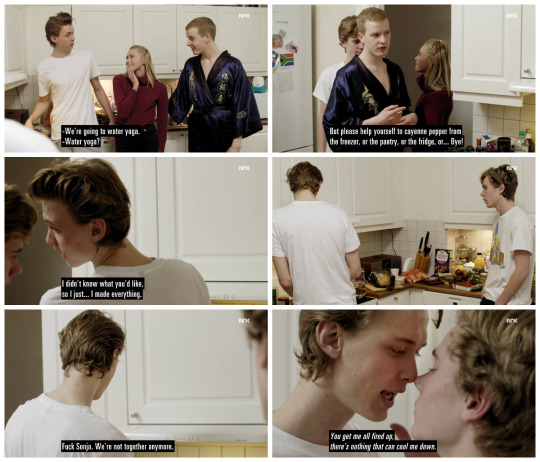
Blink and you miss it: Noora seems more in love with Even than Isak does, she can’t keep her heart-eyes off of him. Blink and you miss it: Noora gives Isak a look to show how proud she is of him for not hiding anymore, and that she thinks Isak has caught a damn fine-looking guy. Subtext: Even is paraphrasing Pretty Woman. Edward orders one of everything from the room service menu for Vivian, because he didn’t know what she liked. Blink and you miss it: Even wasn’t joking, he really did buy one of everything you could possible eat for breakfast. There’s at least two kinds of bread, a packet of granola, butter, tomatoes, avocado, three kinds of smoked ham, cheese, marmalade, juice, mango, the scrambled eggs he’s making, and a bag of carrots(?!). Subtext: Even talks about Sonja while having his back turned to Isak, because he is hiding the truth. He isn’t exactly lying, but he’s not telling the entire truth either. Subtext: The song lyrics to Fem Fine Frøkner matches Even’s mental state perfectly. Unfortunately.
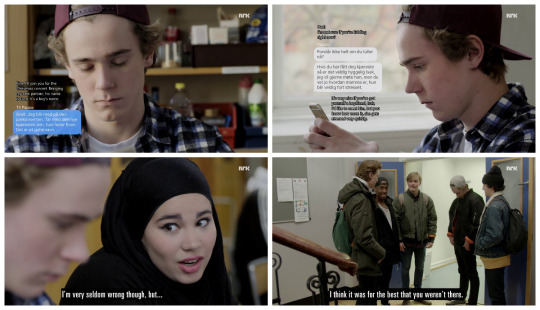
Lost in translation: The Norwegian word for boyfriend/girlfriend, kjæreste, is gender-neutral by default, so sometimes you need to clarify if it’s a boy or a girl. Although in this case, Isak goes over the top, because he wants to shock his dad by coming out to him. Subtext: What Isak’s dad means about mom being easily “stressed” can mean two things. He might think that she will react negatively to Isak coming out, because of her religious beliefs. But he might also think that this Christmas concert was meant for just the three of them, to meet up and reconcile as a family, and if Isak brings another person, it would spoil the entire thing. Blink and you miss it: Sana admits to being wrong. Subtext: The reason it was for the best that the guys left the apartment is of course that Even and Isak had sex. Mahdi is first of them to figure out what Even means, then Jonas, and… who knows if Magnus figured it out, or if he’s just laughing because everyone else is laughing.

Blink and you miss it: After Isak wrote his coming-out-text to his mom, he’s so nervous that his leg vibrates, just like in the scene when he confronted Sana about her religion. Lost in translation: The whole dialogue with the receptionist is a mess, because Even keeps switching between Norwegian, Danish, and English, sometimes in the middle of a sentence. By having everything in English, all of that switching is lost, but here is how the dialogue actually goes: Even: [Danish] This is my boyfriend. Receptionist: [Danish] How nice. E: [Norwegian] Yeah, very nice. Isn’t he handsome? R: [Repeats it, because she doesn’t understand it] Handsome? E: [Norwegian] Yeah, eh… How do you say it in Danish? Lovely… eh… [Danish] Lovely. [English] Uh, what do you say? Isn’t this man beautiful? R: [Danish] Yes, very. E: [Danish] Very [English] beautiful.
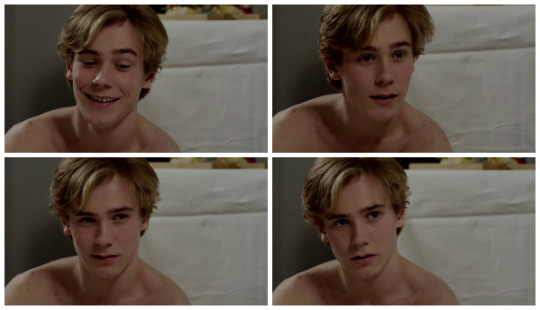
Cinematography: This montage is just here as appreciation for how the acting is un-fucking-believable in this clip, because you really see how Isak goes from happiness to confusion and fear. But let’s talk about the audio in this scene instead. Every scene in SKAM has natural background sounds, unless a song is being used, in which case the song takes over entirely. But usually the background audio makes you feel like you are in the scene, it’s students chatting in the background in school, or it’s the quiet of the apartment when they’re alone, or party music and partying people if there’s a party, etc. Sometimes the show does a diegetic switch, which is when music moves from being something that the characters hear, to something that only the audience is hearing, or vice-versa. In the kitchen scene earlier in the episode you can hear the radio playing Gabrielle in the background, but when Even turns it up, it takes over, and when the scene fades out, the music switches completely to being non-diegetic soundtrack. But in this hotel scene, the background sound is unnatural. If you crank up the volume, you can hear an eerie soundscape, as if High For This never really faded away. It’s closer to a horror movie soundtrack, than the almost-documentary feel the show usually sticks to. And the reason the show does something different here, is that it really wants you to feel unease. It uses all the tricks in the book to make you unconsciously feel that something is Wrong here.
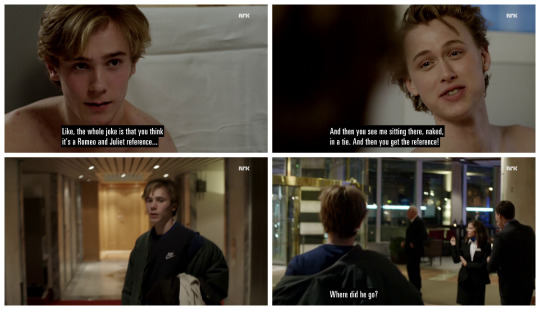
Subtext: The whole joke is that you think this season of SKAM is a Romeo+Juliet reference, double suicide bury-your-gays tropes and all, but it’s actually a Pretty Woman reference, but you won’t get that until Isak rescues Even right back. Ha-ha very funny. Blink and you miss it: Moments ago, Isak was having the time of his life with his cool boyfriend in a cool hotel suite, being cool adults. And then everything comes crashing down, and he transforms into a scared little kid who is just completely in over his head. Subtext: Isak doesn’t need to explain who he is talking about. The hotel staff just saw a naked dude walk straight out on the street, they know who Isak is chasing.
222 notes
·
View notes
Text
Useless Steven Universe Theory:
Gems have the power to project music out of thin air.
I’m sure this has been observed by others before, but there’s no outright confirmation in the show so...basically, all of the singing and music in Steven Universe happens in-universe rather than as a representation of emotions/thoughts like in most musicals. When humans sing the accompaniment is always shown as happening within the show--Steven’s ukulele, Greg’s guitar, Sadie and the band’s instruments, etc.
Gems, however, bring in non-diegetic accompaniment when they sing--instruments the audience hears but doesn’t see. The singing is still singing to the characters, though, as noted by characters like Peridot and Spinel.
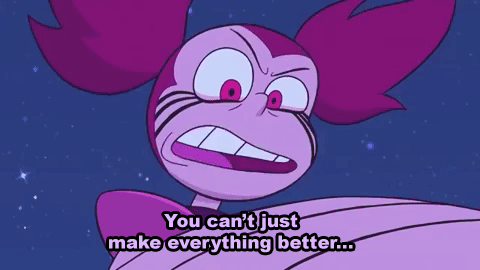
This rule is only possibly broken in Mr. Greg with the titular song and the Empire City song, but then again, Steven is there for the whole time and could be providing those accompaniments. On another hand, Mr. Greg is specifically meant to be a Musical episode, so it might be following the rules of traditional musicals rather than the rules of the rest of the show.
This is a Gem power that Steven develops over time too, like in Full Disclosure when the accompaniment for the song comes from both his phone and an unseen band of guitars & percussion. Before that episode, Steven almost always has physical instruments--except for the Cookie Cat rap in Gem Glow, which...it’s likely that accompaniment was just taking place in Steven’s head. In Coach Steven, it even makes a point of showing Steven turning up his boombox to hear the cool guitar instrumental for his part of “Strong in the Real Way.”
It’s also worth noting that the crew often talks about how each Gem is assigned an instrument (Pearl’s piano, Garnet’s synth bass, Amethyst’s electric drums, Spinel’s reverse violins, etc), and that instrument is usually primary when a Gem sings. Other instruments come in as well, but they’re secondary. Playing your unique personal instrument is like summoning your unique personal weapon!
This isn’t to say all of the music in Steven Universe happens in-universe--I think most of the background score without lyrics is just for the audience, and things like the non-guitar sounds at the end of “I Could Never Be Ready.” Fusion dance music is probably projected in-universe by the Gems, with the possible exception of Malachite’s birth. Then again, maybe Lapis is just That Bitch. She went for the dramatic dip there, maybe she went for dramatic music too.
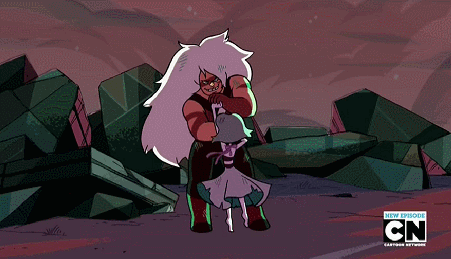
So yeah. All the times in your life where you wished you could have a personalized soundtrack you could hear? Gems can and do. I don’t expect any future seasons to openly acknowledge or confirm this (because, like i said at the top, its completely useless and just a fun little detail), but I am confident that the patterns supporting it will hold up!
#lillie speaks#su theory#su movie#steven universe the movie#steven universe#i actually wrote this before the movie came out and guess what! it held up!#like its. not a hard pattern to keep up granted#but if eventually a human sings a solo with invisible accompaniment and nothing the instrumental could be coming from. ill eat my hat#im posting this now bcus i saw someone made a video that was like 'system.boot but its the way steven and greg are hearing it' or something#and it was just the song without the instrumental#and i got mad like 'NO ITS NOT!! THE INSTRUMENTAL IS REAL ITS THERE!!' and then i realized i might be the only one who actually thinks that#so hopefully this will allow me to not be the only one anymore fsdgfkhjf
26 notes
·
View notes
Text
IB REVIEW: THE IRISHMAN
Written by ishmael Mainoo
An ambitious comeback for a director that needs no introduction, Italian American film director Martin Scorsese’s cinematic adaptation of the Charles Brandt Biography: ’I heard you paint houses’ a detailing the life of Frank “The Irishman” Sheeran and his dealings with the Buffalino crime family, and Jimmy Hoffa head of the teamsters union. Can be described as enthralling. Informative and macabre as well as thoroughly enjoyable. Speaking as a man familiar with the filmography of the ‘new Hollywood’ icon, it was refreshing to see an auteur like Scorsese returning to his artistic roots. Reminiscent of such previous works as Casino and The mafia classic Goodfellas. And with the line-up of an all-star cast. Scorsese could well be likened to Marvel’s S.H.I.E.LD agent: Nick Fury as he assembles his avengers. Seeing him team up once again with the likes of Stout ‘tough guy’ Joe Pesci, The Ragin bull Robert De Niro, And of course Al Pacino. All of whom are no strangers to appearing in the odd gangster flick or two. All this along with the addition of British actor Stephen Graham who has indeed starred in his fair share of crime productions from Tommy in the guy Ritchie film ‘Snatch’ to Chicago mob boss Al Capone in the critically acclaimed HBO series ‘Boardwalk empire’, I think we can safely say this cast will take to any gangster role like a duck to water. And an appearance by Harvey Keitel as the respected Mob boss Angelo Bruno as well as a little something for the young people as new York rapper Action Bronson has a bit part as a coffin salesman, but I digress…
The Irishman is yet another biopic style film about an antihero in Frank Sheeran (Robert De Niro) who’s line of work lead to the slow and subtle dismantling of his family life especially his relationship with his daughter Peggy who witnesses certain sides to her father that she knows are less than pleasant and eventually her fear of him turns to hatred as she realises her father is a cold blooded killer. Within the opening shot we see our silver haired protagonist and humble narrator; Frank Sheeran sitting alone in his section of the cafeteria at a nursing home for the elderly. Almost held in captivity by his wheelchair. As he reminisces to us in the typical Scorsese fashion of breaking the fourth wall. About how life used to be. Treating the audience as an eager child hearing stories of the ‘the good ol’days’ from Grandpa. Showing muted attrition for his acts and almost a sense of self pity in his tone before even getting into the story. The elderly Irish American hitman still has an air of military philosophy in his character. That one could attribute to the character’s time in the second world war as he rationalises his acts as any quintessential soldier would, by stating he was only following orders.
From a technical standpoint the film’s cinematography was nothing short of trademark Scorsese, the tracking shot through the nursing home and into the room where frank sits, almost emulating the single take done by Henry and Karen Hill entering through the staff entrance at the Copacabana club in Goodfellas, or the quick cross cuts between Jo Hoffa (Welker white) turning on her ignition and an exploding car from another job. Indeed, it is the suspense created from the long pause of Jo anxiously awaiting to turn her engine on that transforms the scene alone into something of sheer brilliance. The Irishman to me was a testament to the scorcese cinematic mafia world. And will leave you either fascinated with the mafioso subculture or leave you ultimately disgusted with their heinous and nonchalant behaviour to murder. However unlike Goodfellas, casino or even the wolf of wall street, I found the film to be ‘an acquired taste’ if it so can be called, unlike it’s predecessors I found that the film was more dialogue driven than films before it and set at a slower pace. Compared to the aforementioned names. Well written though the film was and with the certain east coast lexical flair which all added to a believable and natural dialogue. I couldn’t help but feel that this came at the expense of momentum for the film. even the opening scenes of Scorsese’s films beforehand struck you with action from the very beginning. Whether it’s three guys driving at night with a halfdead body in the trunk. (Goodfellas). or a Casino boss leaving a restaurant ready to turn on the ignition in his car only to unknowingly detonate a car bomb (Casino). Or even a midget toss at an office party in the heart of New York’s financial district. (The Wolf of Wall Street). I feel that if the Irishman was a horse it is in no way shape or form a front runner and is a film that requires a viewer’s patience.
Which is probably why a handful of viewers (philistines) complained after it’s initial release stating it to be ‘boring’ and ‘too long’, I can empathise with these people on the ‘boring’ part, upon my first viewing even I had to wave my cursor to check the time marker to see how long I had left of this picture. However, to simply complain a film is ‘too long’ is in my mind nothing short of nonsense. Especially if you are familiar with Scorsese’s works: The runtime for the Wolf of Wall street is exactly three hours, Goodfellas two hours and twenty-eight minutes and Casino at Two hours and Fifty-eight. To conclude the runtime of a film should have no bearing on the quality of the film itself. And would not be a problem for most were the film more visually stimulating. Where the wolf of wall street, casino and Goodfellas featured frequent fast cuts and dynamic shots of abhorrent drug use, rampant sex, and/or poor bastards getting their brains blown out. All set to a multitude of complimenting soundtracks by artists such as Ray Charles, The rolling stones, Smokestack lighting or frank Sinatra etc. The Irishman had a distinct lack of all mentioned. However, this muted tone made for a more earnest watching. instead of relying on fast cuts and music sequences, it relied on the tension created by nuances in dialogue. The tension was even made sharper by the lack of non-diegetic sound. Seen multiple times especially when Tony Slaerno and Russel Buffalino (Joe Pesci) Tell Frank to persuade Jimmy (Al Pacino) to retire. (Essentially, ‘tell him to retire or we whack him’)
To the finish, the film’s story as a whole reminded me of Goodfellas in the sense of a character being indoctrinated into the mob life and showing the day to day stresses and moral dilemmas of working in such a career. Such as attempting to blow up a laundry place only to find out before the act that it belongs to your mob boss. And trying to prevent your hot-headed friend from getting killed by your employers. However I believe this picture goes a step further by showing how our protagonist got to work for the mafia - what life was like working for the mafia - and life after the mafia as an old man riddled with arthritis. Which leaves one to almost sympathise with this Irishman. As he sits alone in his nursing home. Isolated from the open world, with all his friend’s dead. Or in prison and a family that wants nothing to do with him because of who he was.
1 note
·
View note
Text
RWBY Recaps: Ruby Rose
This is a reposting from Sept. 22nd, 2017 in an effort to get all my recaps onto tumblr. Thanks!
I am combat ready! Or at least writing ready. For ages now I've wanted to tackle a comprehensive recap/analysis of each RWBY webisode and what better time to start then a few weeks before Volume 5? Though I'll mostly be sticking to plot points as they occur chronologically, any new RWBY viewers should be aware that recaps will include spoilers, mostly in the form of referencing foreshadowing and parallels. Read at your own risk.
Let's get started.
Our series technically opens with four trailers (which you can no more skip than Doctor Who fans can skip Nine), but for the purposes of this recap we're saying that we start the show off with an origin tale. A fairy tale, if you will. Our very first shot is of a high tower decked out in green, beacon-like lights that I'm sure are in no way symbolic standing atop it.

Our narrator, an unknown woman, begins with a cryptic message:
“Legends, stories scattered through time. Mankind has grown quite fond of recounting the exploits of heroes and villains, forgetting so easily that we are remnants, byproducts of a forgotten past.”
Obviously not everyone has forgotten these legends, considering that she's the one telling us them, but right from the start there's a dichotomy set up. There are people, humans, who view the past as something that inherently includes them. Any myths that are passed down are about humans--they're the "exploits of heroes and villains." However, this woman reminds us that there was an existence long before mankind was created; that the world, its history, and its power is far more vast than we're willing to acknowledge. Or able to.
We're small in comparison. We're just "remnants" of something far larger.
(Also, interestingly, note the "we" in "we are remnants." We learn a lot about Salem later on and no matter how she might look or act, she seems to view herself as human.)
From there on we're given the story of man's creation. Born from dust into an "unforgiving world" already populated by monsters, were it not for their discovery of certain elements--a power that they named "dust" after their own origins--they never would have survived, let alone flourished. Power allowed for civilization. As the story supposedly resolves, we get a change in animation style, moving from the story-book imagery to the real world. The focus on a shattered moon suggests that, despite humanity’s success, things are not all peachy-keen.

Also, enter these guys.

This is Roman and I just love his entrance. RWBY is a show that is very overt in its tropes and homages, and though there's complexity later on, for now Roman and his goons are pretty straight-forward. They're Bad. How do we know they're Bad? Because they're creeping out of the shadows late at night. We've got this guy smoking in an age where the habit is thoroughly demonized. All his goons are pretty identical in true, gangster fashion and Roman himself is the most flamboyantly dressed, drawing on a long (and very problematic) tradition of queer-coding villains. He's wearing a bowler hat for heaven's sake, which is basically just a step up from a fedora.
He's also a redhead. That'll be important.... later.
For now, Roman struts down the street (giving us a hilarious first-look at RWBY's silhouette background characters) and Salem changes her tone, suddenly sounding far more menacing as she lays out humanity's inevitable destruction. All lights "flicker and die" and we're warned that "there will be no victory in strength." The only thing that keeps the scene from becoming depression central is the introduction of a new voice, a man's that--if you're paying attention--you'll recognize later in the episode:
"But perhaps victory is in the smaller things that you've long forgotten. Things that require a smaller, more honest soul."
Pan down to this cutie.

Wow! I wonder who the small, honest soul could be?
(Also take note of the ad on the back of the magazine: the Schnee logo with the tagline "The Finest of them All." Weiss, based off of Snow White, is therefore "the fairest of them all." Or at least she thinks she is.)
Roman barges in and starts talking about how hard it is to find a dust shop open this late which... raises a number of questions for me? Like why they're looking for a dust shop that's open at all. Why not just wait until everything is closed down and then rob the place? It certainly wouldn't be hard to break in. Given what we know of the villains' larger plans in Volume 3, it could be that they want to sow fear in the people of Vale by committing robberies in plain sight (recall the horrified background characters as Roman walks by), but if so why not actually attack in broad daylight? Overall it just seems like a strange comment.
We're given our first glimpse of Roman as an ambivalent villain as he refuses the shopkeeper's money. He's here only to complete his mission of stealing dust, not entirely wipe the guy out so... yay, I guess?
One of the goons notices our little red riding hood and pulls a sword on her, which is kind of hilarious. I'm not even sure why. Maybe it's because right after that a different goon pulls out a gun which is obviously the more logical weapon here. But no. Goon #1 needs his massive, red sword to threaten the small child with.
Small Child is not impressed.
"Are you robbing me?"
"Yes!"
"Ooooh."
And she proceeds to kick him from the back of the store all the way into the far wall.
Let's take a moment to appreciate Roman's dafaq face here:

This is a technique nearly two decades old. Everyone knows the story of how Buffy got started. Whedon wanted a stereotypical heroine--small, cute, blonde--but who, rather than getting killed by the monster in the alleyway, ends up being the very thing that the monster should fear. It's an oldie now, but a goodie. We're presented with this tiny, adorable girl who is characterized as a victim, only to find that she's the one with the most power. Not only can she kick a full-grown man across a room, she's got some crazy weaponry tucked away too.

This is, by definition, a badass moment.
As we see in the ensuing fight this little girl is very proficient with her scythe. There's a great moment as her headphones play "This Will Be the Day" diegetically, only for the song to move into non-diegetic soundtrack, and then back to diegetic music as she turns off her headphones and... they disappear? Presumably she has pockets.
Iffy animation aside, RWBY seems like the kind of world that would give its girls pockets.
Roman: "Okay... get her."
That little moment of confusion--Roman's disbelieving "Okay?"--seems a little like inconsistent world-building. Certainly he knows that Signal and Beacon aren't too far from here, meaning that there are lots of teenagers around, Huntsmen and Huntresses in training that are capable of kicking his henchmen's ass. Is he just thrown off guard by this girl's (even younger) age? Who can say.
Regardless, she handles all the goons with ease. Ruby (yeah, let's just use all names for simplicity's sake) has a direct and efficient fighting style. This is our first glimpse into the maturity hiding behind a seemingly immature outer shell. Ruby doesn't take the time to taunt the goons or get all flashy with her fighting, she just takes them out, pure and simple, something that young and confident heroes often struggle with. Roman proves a little harder though when his cane turns out to be a gun.
Lesson One: pretty much everything in RWBY is a gun. Cane? Gun. Scythe? Gun. Thermos? Gun! That lamp? Probably also a gun.
As Roman escapes we get another glimpse of Ruby's priorities when she asks the storekeeper, "Are you okay if I go after him?" It's a small but wonderful moment that tells us Ruby isn't a hero who wants to fight for the sake of fighting, at least outside of friendly competitions. Had the storekeeper been injured or needed her for some other reason, Ruby would have held his needs above just catching the bad guys. That's important.
So, having gotten the a-okay, Ruby chases Roman up to the rooftops and we hear his annoyed (yet impressed?) mutter of, "Persistent." Just as they're about to duke it out again an airship arrives that Roman boards, throwing out a dust crystal that explodes when he shoots it. It looks like Ruby might have been caught in the blast, but at the last possible second Glynda Mother-F***ing Goodwitch arrives to save the day.

Why was she out in town this late at night? How did she feel seeing some tiny child fighting a notoriously wanted criminal up on the rooftop? These are questions only fanfic can answer. The point is that Glynda saves Ruby not once, but twice, all while exhibiting a truly impressive amount of power. It's here that we first get to see not just fantasy weapons, but what we might term magic (in what will quickly become a fairly convoluted magical system). It isn’t until later that we realize others don’t consider Glynda’s abilities to be magic, though given what we now know about semblances and their assumed connection to Humanity 1.0, it’s perhaps no coincidence that the audience is meant to think this is magic at first glance. But telekinesis--the ability to manipulate anything from objects to the weather itself--is staggering nonetheless and the show should really give Glynda something else to do with her power besides fixing craters and broken buildings. Or just bring her back, period.
Glynda even makes a little "Humph" sound when she blocks the blast like, "Please. You'll have to try harder than that."
They do.
Roman yells to the pilot that they have a "Huntress" to deal with and we're given glimpses of a more important villain: fancy dress, high heels, strange tattoo on her back, and an affinity for fire. She's deemed important simply by the fact that the 'camera' always keeps her face hidden from view, inviting speculation as to who she is and what her motives are. Though she and Glynda seem pretty evenly matched (with Ruby joining in to help), Roman flies them out of there before things get more heated. Pun intended.
As a side note, it’s worth pointing out that, in retrospect, we did just see magic with Cinder... which we then assume for a very long stretch was her semblance given what we quickly learn about Glynda. You can see why this stuff gets muddled. The fact that Ruby, a bright and fighting obsessed girl, doesn’t seem to think it odd that someone can shoot fire just hammers home how not magic-y these abilities read to characters in world. Until the plot suddenly wants them to. AKA bird anger.
Regardless, as the viewer cheers at the rarity of three women dominating a fight scene, Ruby has bigger things to think about. Like the fact that Glynda is a Huntress and Ruby just has to have an autograph.
Cut from this:
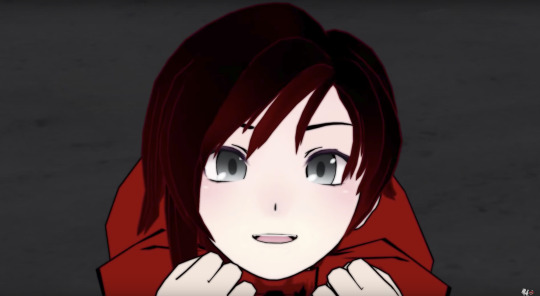
To this:

Humor aside, this actually does a lot for situating what a Huntress is in the viewer's mind. We might not have an exact definition yet, but we know two important things: they're on the side of our small hero (Glynda protects Ruby) and they're regarded as at least minor celebrities. In short, they're the Big Good to the mysterious Big Bad.
They’re also, as we’re about to see, subject to the law.
But back to Ruby. See that spotlight? Glynda has this 15yo girl in an interrogation room, prowling about while lecturing that she "put herself and others in grave danger." Interesting. What others were in danger? Civilians? Looks like everyone else cleared the streets once Roman showed up. The shopkeeper? As said, Ruby was very careful about making sure he was okay. Normally I’d be 100% on Glynda’s side here, but I think Ruby actually acted very maturely given the circumstances. Especially considering that she’s right: they started it. Glynda’s generic reprimands might imply that there are many non-Huntsmen trained fighters out there making a mess of things (at least by Glynda's standards). Certainly we later see conflict between trained Huntsmen/Huntresses and those who learned to fight "outside the kingdom."
Also... just reminding everyone... that Glynda uses a riding crop. Rooster Teeth had to know the can of worms they were opening with that little choice. If you don't want porn of the deputy headmistress and various other characters, don't dress her like a dominatrix and give her lines like, "I'd have sent you home with a pat on the back... and a slap on the wrist!"
Glynda is very serious that Ruby would be in big trouble if it weren't for the fact that a certain someone wants to meet her. Enter my trash fave:
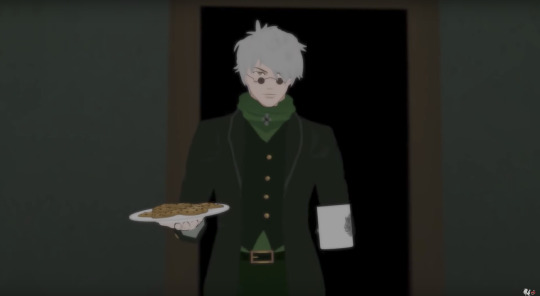
Ozpin.
He's basically Dumbledore if he actually had better justifications for his iffy decisions and looked like a hot 30yo. My priorities aside, more fascinating questions start cropping up. How long has Ruby been held in this room? What was that conversation between Glynda and Ozpin like--Hey, I found this random child who nearly took out a whole criminal gang, that seems like your kind of thing? Why does Ozpin arrive with a full plate of chocolate chip cookies? Did he bake them himself? Does Ruby ever get Glynda’s autography?
These kinds of questions are the lifeblood of fandom.
As an aside, I'm a complete animation snob. I've been spoiled by too many great artists to immediately accept just anything you throw up on screen. When I first watched this episode and saw Crunchy Roll's review that RWBY is "lovely to look at" my response was, "...seriously?" This moment, when Ozpin gives Ruby the cookies and they proceed to just disappear as they approach her mouth was my breaking point for a while. I had to be talked into watching more... and I'm so glad I was. Now, after years with these characters, I have a much deeper appreciation for the art style and the beauty that RWBY contains. Now the cookie scene is just straight up funny to me.
Back to plot though. Ozpin introduces himself by introducing Ruby. We get her name for the first time and as Ozpin peers down at her he says, "You have... silver eyes," which confuses Ruby and has the viewer nodding sagely. Yep. That'll come back later.
Ozpin reviews Ruby's fight and wants to know where she learned all that. More specifically, he wants to know who taught her to use "one of the most dangerous weapons ever designed," which is another fascinating moment that I think is largely overlooked by the fandom. Ruby is living in a world chock-full of crazy dangerous weaponry. Already we've seen a gun-cane and a riding crop used as a wand. The fact that Ozpin labels Ruby's sniper-scythe as one of the most dangerous not only re-emphasizes her skill, but hints that the scythe may be a particularly powerful weapon... one even he might favor. Though we later get to see Ozpin fight with his cane and he clearly prefers that form, we've yet to get a full explanation for those gears in it:

In retrospect after Volume 6, there’s little evidence that his cane turns into a full other weapon, but it was an cool theory for a while.
Ruby says proudly that her Uncle Qrow taught her everything and that she's currently a student at Signal Academy.
Ozpin: "And what's an adorable girl like you doing at a school designed to train warriors?"
Ruby: "Well... I want to be a Huntress."
Ozpin: "You want to slay monsters?"
Ruby: "Yeah."
Ruby launches into an excited speech about following in her big sister's footsteps, looking for a career that's more "romantic" than the police, and above all getting to help people. Watching Ozpin in this scene gives us a pretty clear view into his thoughts: his shock at Ruby's proficiency with the scythe, making sure he's reading the situation correctly (this small, adorable child wants to fight evil?), his look of approval as Ruby tries to explain her thinking. There's even what I read as a little test. "You want to slay monsters?" A major theme in RWBY is that people are the real monster, the biggest threat, and it takes Ruby a long time to learn that. To semi-quote Sirius, the world isn't split into good people and Grimm. Though Ruby doesn't realize this yet--she just implies that she wants to fight Grimm--her skill and pure intentions (which will come into play later during "Mountain Glenn") are enough for Ozpin to offer her a place at Beacon two years early. As we learn later, as an added bonus this also helps keep her safe. Those with silver eyes are hunted and Ruby has not been keeping a low profile.
"You want to come to my school? Well... okay."
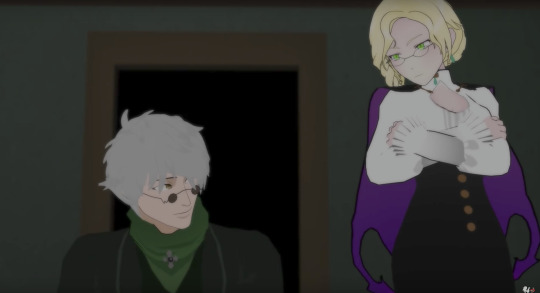
One of these teachers is happier about this situation than the other.
It’s pretty amazing though.
Yang thinks it's amazing too. We jump ahead an unspecified amount of time to meet Ruby's half-sister on the airship to Beacon. I adore their interaction here because so often media limits sibling relationships to arguing and competition. Not so with these two. Yang isn't at all jealous that her little sister is getting special treatment. Ruby is the only one with issues:
Ruby: "I got moved ahead two years... I just don't want people to think I'm special or anything."
Yang: "But you are special."
Ruby just wants to be a normal girl with normal knees. No bee's knees allowed.
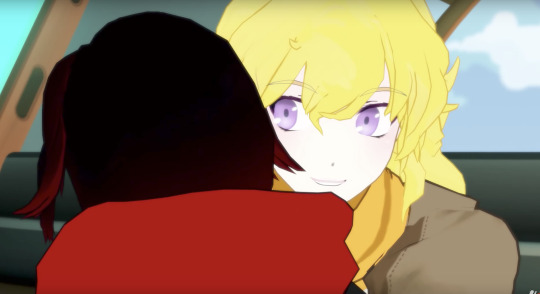
As Ruby begins struggling with her new situation we get Roman's name in a news bulletin, along with a hilariously different art style.

We also get reference to people called "Faunus" who possess animal traits, their civil rights movement, and the violent organization called the White Fang that recently interfered in a peaceful protest. The bulletin is cut off by a holographic Glynda's welcome.
Yang: "Who's that?"
Glynda's hologram introduces herself immediately after, but I find it funny that Ruby doesn't even look like she's going to try and answer. As if she hadn't met and fought alongside Glynda just a little while ago. Also. Ruby knew exactly who Ozpin was. Didn't have a clue about Glynda. Poor Professor Goodwitch does all the work around Beacon and receives none of the credit lol.
I actually really like Glynda's speech here though. She's welcoming to the students without coddling them. Like other shows with children entering combat, RWBY lets the viewer know that we can't always apply our real-world morality to these situations. These kids might be young--17 years old and 15 in Ruby's case--but they're going to be treated like adults for as long as that’s logical. As we’ll see later though, there’s a distinct difference between responsibility inside school and out...
Right before our pilot ends we're introduced to Jaune, or the name we know him by so far, "Vomit Boy." The webisode ends on a light note with Jaune getting puke on Yang's shoes and the two sisters freaking out about it. We're also given our first, gorgeous look at Beacon:

Now that’s animation I can get behind. Everything is light and happy. Ah, they have no idea the horror that's coming for them. Just wait until Volume 3.
Until then, 💚
13 notes
·
View notes
Text
chicago (2002)
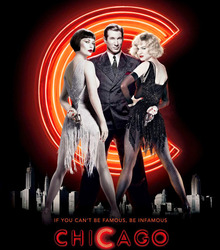
chicago is the story of two murderesses (velma kelly and roxie hart) set in 20s chicago (duh). it’s a musical so bye everyone who just checked out!! the songs are sexy, smoky vintage jazz and the cast BANGS (auntie tanya from mamma mia anyone?) it’s funny and showy and bursting at the seams with glamour but most importantly it doesn’t take itself too seriously. also catherine zeta-jones got an oscar for this movie so if that doesn’t sell it to you i honestly don’t know what will
allow me to preface this review by saying: if you haven’t seen chicago yet, get in the bin
seriously go watch chicago
it will make you want to kill a man with a stiletto whilst dragging on a cigarette
okay now that we’ve got that out of the way, chicago:
can we PLEASE talk about how hot catherine zeta-jones is?? even with THAT haircut. she is the only person on god’s green earth who can pull that off

DOMINIC WEST I LOVE YOU AND YOU ARE PAINFULLY UNDER-UTILISED IN EVERYTHING (also in my head he is andrew scott’s husband and nothing can unravel that connection) (also side note could he not be dominic cooper’s dad. like they have the same face. and name. sorry distracted)
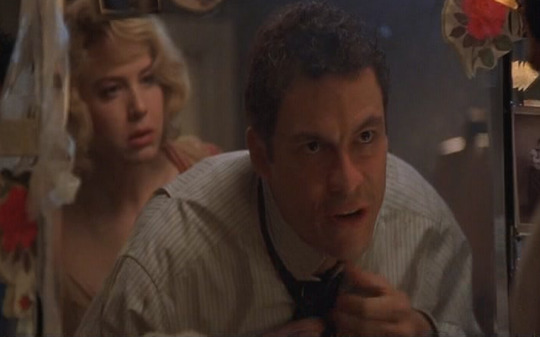

ahh. renee Zellweger. she’s cool! she’s fine! she’s bridget jones! she just…….. has a very tense face. are we meant to be rooting for her in this? because roxie is low-key a bitch.
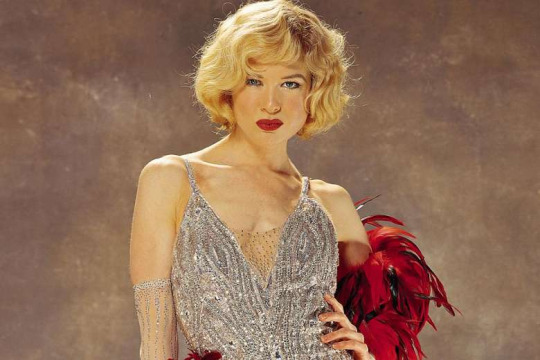
‘and all that jazz’ is SUCH a banger. and is interestingly one of the two diegetic songs in the film (idk if we count ‘but I can’t do it alone’)
on that note, let’s talk about the film’s use of diegetic music! lindsay ellis did a really interesting video on diegesis in film so check that out for a MUCH better explanation but essentially, diegesis is anything that happens within the premise of the film (i.e. ‘and all that jazz’ actually is sung by velma kelly in the film at the club). on the other hand, non-diegetic music is any music that does not actually happen within the confines of the story. this is the default for music in film – most soundtracks are non-diegetic as there usually isn’t ACTUALLY a 50 piece orchestra sitting camera right (sorry, titanic).
chicago uses the theory of diegesis pretty uniquely, as most musicals do operate on a non-diegetic system (the musical numbers are usually metaphorical and don’t tend to require explanation within the film). by contrast, chicago does provide an explanation for the non-diegetic musical numbers: they’re happening in the protagonist’s head as her way of coping. this really WORKS because it not only makes the film both stand out and make more sense, but also adds another layer to roxie’s character and reaffirms her obsession and dreams of stardom. go movie.
john c. reilly is that dude that has been in every film under the sun and you still have no idea what his name is
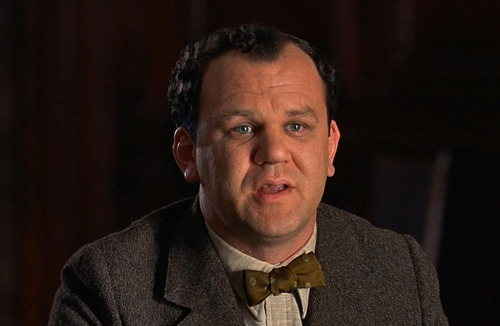
okay let’s address the elephant in the room:
the SINGING
catherine is killing the damn game holy calzone triple threat who???? hot damn

renee zellweger! okay i see you girl! doing The Most™! we get it calm down you’ll pop a damn vein
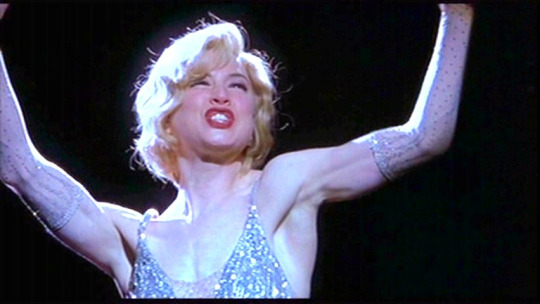
queen Latifah could push me into a volcano chanting ancient cult hymns and I’d climb out again just to hear her finish that woman has a VOICE (also how gorgeous my lord she just glows)
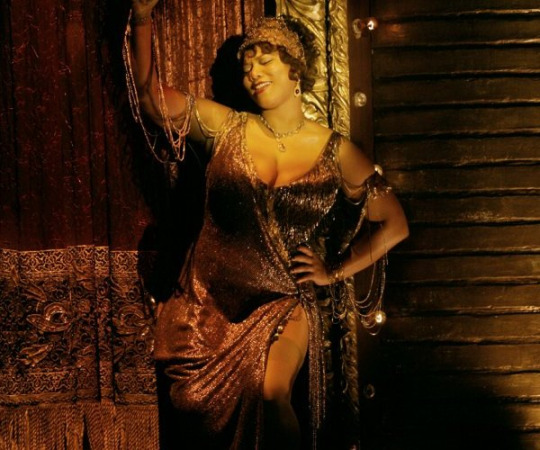
richard gere is a sexy, sexy man. i don’t care what you say about his singing i’ll just stare at his face and pretend i can’t hear
who else sings um
oooh the CELL BLOCK TANGO
okay but like?? none of those characters ever come back again?
byeeeee
also 5 of them literally caught their husbands cheating or whatever and the first lady shot him twice for CHEWING GUM
like i get it’s annoying but overkill?
anyway I think between chicago and moulin rouge we’ve proved that every good movie needs a tango (honestly could have saved tlj don’t @ me :) rian johnson u listening?)
in ‘all I care about is love’ how does he get those boxers off in one swipe?? get u a man like that
remind me why billy took the case for less than half his asking price? what changed his mind?
i love the aesthetic of this film but i feel like they really could have pushed it further and made it sexier and smokier and glitzier soz
that LUCY LIU cameo yum

czj’s accent omfg she’s WELSH GUYS she’s actually magic
i actually really liked how every set looked like a set (let’s face it the prison looked as real as a £3 note) – it really tied in to the whole performance and entertainment and just general SHOW vibes of the film. good job
roxie u SNEAKY BINCH with that pregnancy story
‘we both reached for the gun’ is high key super creepy (giant puppeteer richard gere anyone) but such a cool concept

ohh that was a BOOB GRAB
RICHARD NO
... richard yes?
you know what’s sad? this film was nominated for thirteen oscars in 2002. it won six. including best picture. and you just KNOW that it wouldn’t even win like…… hair and makeup now. why do pictures have to be arty and subtle to win oscars?? like i get indies are often better quality and more original but you can still get amazing big budget studio movies. just a thought.
the closing number is an absolutely perfect ending for this film – it’s satisfying and slick and cut throat
anyway chicago is an absolute riot and makes for super fun viewing so I’m giving it:
8/10
(it was well made, good acting, fun story and just an absolute blast to watch and listen to!! loses points for not giving dominic west enough to do (your problem not mine) and for roxie being just the most annoying goddamn ‘’’’’protagonist’’’’’ ever)
SPOILERS (it won’t let me put two cuts ffs tumblr what are u doing)
can we please talk about the seismic tonal shift that was the execution of the innocent hungarian lady? it was an incredible sequence but felt really out of place and i wasn’t 100% sure why it stayed in? i guess it was to strike fear into the audience that that could happen to roxie buuuuuut…… let’s be real we couldn’t give a flying MONKEY’S about what happens to roxie (to quote demi: sorry not sorry)
#chicago#renee zellweger#catherine zeta jones#john c reilly#richard gere#dominic west#film review#long post#musical#chicago (2002)#dance#2002#movie#film#critic
21 notes
·
View notes
Text
Kinetic Typography
Kinetic Typography is what moving text on videos is called basically. The idea is that its a word or sentence thats animated to have some form of character or life when it hits the scene so it can bounce or move or basically have any form of characteristics. It's a good way of making a good amount of text appear on screen without boring the audience as it shows the info in a interesting way which is way you can see kinetic type in a lot of adds and commercials. The example below is a phrase from a popular game called oblivion.
youtube
https://www.adweek.com/digital/kinetic-typography-as-a-storytelling-technique-2/
It's important to note that the kinect text does not suit every video as there are some situations in where the still text will work more effectively in a video that text that moves and expands and over exaggerates itself. Like logos the font is important for these text types as it can add moods and set the tone for what a product is or a company is looking to promote for example connected wavy text may work for weddings but wont sell auto parts while a strong, solid, straight text will work more better for the selling of auto parts. Below is an example of solid text at work.
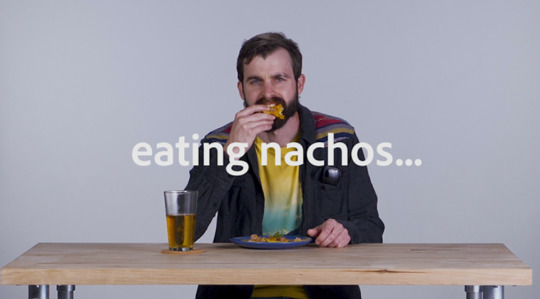
https://www.premiumbeat.com/blog/5-considerations-adding-text-video/
Sound
The sound in films is basically everything you will hear in the film including sound effects, dialogue and music. These are used to better a film and replace some sound with better sound such as better Foley sound or more enhanced Foley sound. The sound helps convey the emotions of a scene and helps engage audiences.
The main two sound categories are Diegetic sound and Non-Diegetic sound. The Diegetic sound is basically sound that relates to the audio that comes from the sources in the film such as natural tree and bird sounds even dialogue from people and their footsteps for a few examples. Non-Diegetic sound is the sound that comes from the edit in film or fictional sound meaning things like soundtracks of music and sound effects or exaggerated Diegetic sound such as loundend footsteps or waterfalls for example.
http://thecinematheque.ca/education/wp-content/uploads/2012/02/LanguageofFilm07.pdf
youtube
youtube
From the videos above that were researched the diegetic sound was mute or cut from the actual video. In some videos the only real audio that was used was voice over from the students which is an idea due to the video being for students. The video may work better with thoughts from students in the film. The other idea for the film was to use piano music as the idea is to start with a piano being played and then play the music with the same notes, the other reason for doing instrumental audio is most of the videos that have been uploaded in the category have basic instrumental beats with no singer most likely as it would seem like the video would be to crammed with content mainly for this particular video as the time limit is 1 minute.
youtube
youtube
Referencing
www.adweek.com. (2018). Kinetic typography as a storytelling technique. Available: https://www.adweek.com/digital/kinetic-typography-as-a-storytelling-technique-2/. Last accessed 12/11/18.
www.premiumbeat.com. (2018). 5 Things You Should Consider When Adding Text to Video. Available: https://www.premiumbeat.com/blog/5-considerations-adding-text-video/. Last accessed 12/11/18.
www.inpoint.com. (2012). Sound in film making. Available: http://thecinematheque.ca/education/wp-content/uploads/2012/02/LanguageofFilm07.pdf. Last accessed 12/11/18.
0 notes